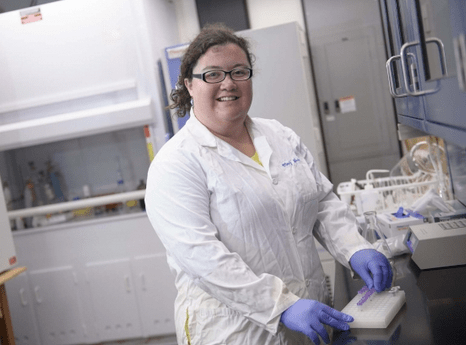MSU scientist wins NASA fellowship to explore early life on Earth, other planets
Tuesday Jun. 28th, 2016
A Montana State University graduate student who wants to better understand early life on Earth and the potential for life on other planets has received a one-year, $30,000 fellowship from NASA, with the potential to renew it for two additional years.

Melody Lindsay, of Honolulu, Hawaii, said the Earth and Space Science Fellowship will allow her to continue sampling hot springs in the world-class laboratory known as Yellowstone National Park. Besides examining the influence of hydrogen on microorganisms that thrive in the extreme conditions of the Norris Geyser Basin and other thermal areas, she will use her fellowship to analyze and present her findings at the NASA AbSciCon conference and, potentially, other scientific conferences. The fellowship will also allow her to pay tuition and other expenses as a third-year doctoral student in the Department of Microbiology and Immunology in the College of Agriculture and the College of Letters and Science.
"It's really great," Lindsay said. "Not only do you get to work on your research, but you get to present it."
Eric Boyd, Lindsay's adviser and an assistant professor of microbiology and immunology, said the fellowship is extremely competitive. NASA's Earth and Space Science Fellowship Program offers fellowships in four areas of research, and more than 700 people applied for the 2016 awards. Lindsay was one of 28 who received a fellowship in planetary science.
Boyd said the fellowship is another major achievement for Lindsay, who has already accomplished much in both science and music.
Lindsay, who grew up in Honolulu the daughter of a physicist and musician, was also one of 20 U.S. college students selected to attend a June 20-24 conference in Spain. The 2016 International Summer School in Astrobiology allowed her to learn from some of the world's leading experts in astrobiology, a field that focuses on the origin, evolution, and future of life in the universe.
Lindsay is also lead author of a scientific paper accepted for publication in an upcoming issue of the journal "Geobiology." The paper -- her first as lead author -- was the culmination of research conducted in one semester by 10 MSU graduate students who took a course last fall from Boyd and MSU Earth Sciences Professor David Lageson.
"This is a super phenomenal time in her life and her career," Boyd said of Lindsay. "She is rising to the top, and it's fun to watch. It's fun to be a part of."
Before coming to MSU, Lindsay earned her bachelor's degree in ecology and evolutionary biology from Princeton University. A harpist as well as a scientist, Lindsay attended Princeton with a $50,000 fellowship from the Davidson Institute for Talent Development. Saying science won out over music, she nevertheless continues to play the harp for the Great Falls and Billings symphonies and occasionally plays a small harp while in Yellowstone for fieldwork. She has performed on NPR, her first time at age 13.
Lindsay said she met Boyd at an American Geophysical Union conference where she presented her undergraduate research on microbial life almost two miles below the surface of the earth in the gold, diamond and platinum mines of South Africa.
"I came to MSU because of the research Eric is doing, which is amazing," Lindsay said.
Although she encountered a grizzly bear and two cubs on her first day as a graduate student and her first day in Yellowstone, Lindsay said the opportunity to study extremophiles in Yellowstone National Park is incredible.
"To continue in the same line of work would be phenomenal," she added.
Boyd, who has many achievements of his own, was a NASA Early Career Fellow, won a NASA Astrobiology Institute Postdoctoral Research Fellowship and is deputy director of a $7 million NASA project to investigate the origin and future of life in the universe.
"He's wonderful," Lindsay said. "The opportunities he gives all his students are just insane. It's amazing what he can do for his students, what he has done. Plus, he's fun to work with."
Boyd, who currently supervises five graduate students, said he remembers the frustrations of graduate school so he looks for ways to keep his students excited about their research.
Besides going to Spain and starting her NASA fellowship this summer, Lindsay will also travel to Alaska to conduct fieldwork on mud volcanoes in Wrangell-St. Elias National Park. Max Amenabar, another of Boyd's students, spent six weeks in 2014 on a research ship best known for carrying researchers to the sunken Titanic. Amenabar was part of a team looking for microbial life in 3-million-year-old sediments beneath the floor of the North Atlantic Ocean.
| Tweet |